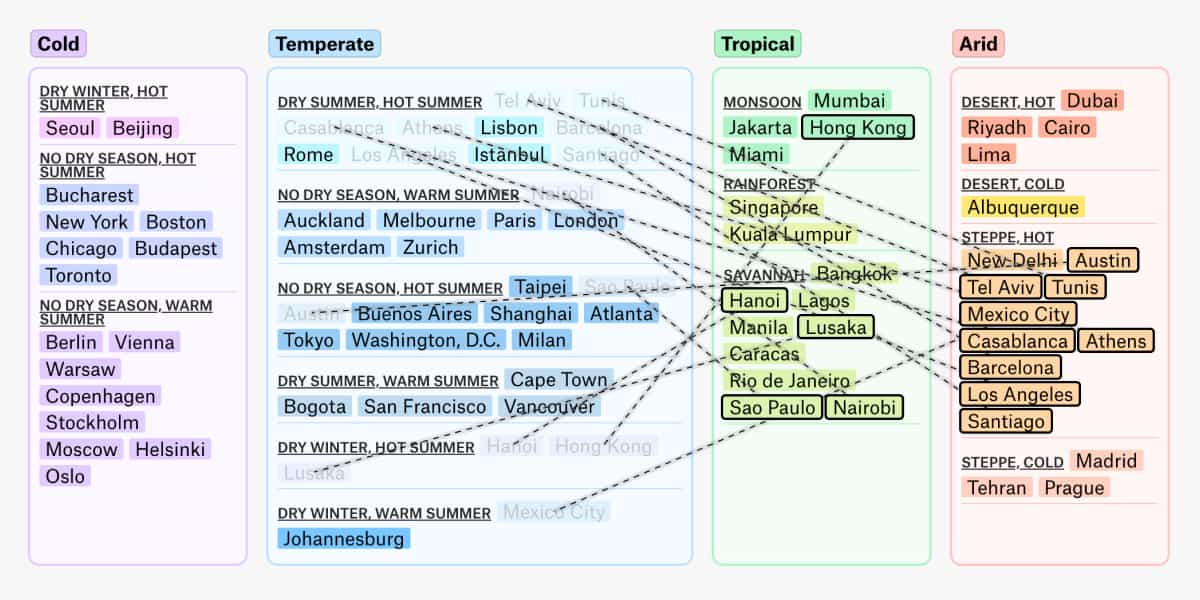Explore present and future climate zones for dozens of global cities. “With climate change, your city isn’t just getting hotter: it will resemble the distinctive climate of completely different places.”



Advertise here with Carbon Ads
This site is made possible by member support. 💞
Big thanks to Arcustech for hosting the site and offering amazing tech support.
When you buy through links on kottke.org, I may earn an affiliate commission. Thanks for supporting the site!
kottke.org. home of fine hypertext products since 1998.





Comments 1
This is similar in many ways to CityApp which came out in late 2018 as I recall. The kind of data these apps present is interesting but incomplete (and somewhat misleading). One thing both of them leave out is how the speed of the changes they present are often too fast for an area's "native" flora and fauna to adapt to.
You can, for example, find out using CityApp, that in 2080 Montpelier, Vermont will be much like current day Barnhart, Missouri. It is easy to imagine someone in Vermont looking at that and thinking, "Well, heck! Isn't that near where Aunt Betty lives? And she likes it just fine there!" It's less easy to also imagine what moving Barnhart's climate up to Montpelier would do its local plants and animals, but it wouldn't be pretty.
Another problem with these apps is that they wrap a timeframe around their presentation and pretty much ignore its artificiality. Climate change doesn't magically stop in 2080 (or wait until then to ramp up temperatures). The momentum behind that change (and behind the physics that is causing that change) doesn't suddenly dissipate. It keeps on building, making things hotter, year after year, decade after decade until the root causes are reversed or eliminated.
We're not very good at imagining things like that. We're better, for example, at understanding 2023 was the hottest year yet than we are at coming to terms with the near certainty that 2023 is also cooler than all the years that follow. We've just recently experienced our first 12-month period with a +1.5°C anomaly (compared to the preindustrial average). In less than a decade we will have experienced our first 5-year average above 1.5°C and by 2050 we're very likely to have had our first +1.5°C 30-year average.
Hello! In order to comment or fave, you need to be a current kottke.org member. If you'd like to sign up for a membership to support the site and join the conversation, you can explore your options here.
Existing members can sign in here. If you're a former member, you can renew your membership.
Note: If you are a member and tried to log in, it didn't work, and now you're stuck in a neverending login loop of death, try disabling any ad blockers or extensions that you have installed on your browser...sometimes they can interfere with the Memberful links. Still having trouble? Email me!
In order to comment or fave, you need to be a current kottke.org member. Check out your options for renewal.
This is the name that'll be displayed next to comments you make on kottke.org; your email will not be displayed publicly. I'd encourage you to use your real name (or at least your first name and last initial) but you can also pick something that you go by when you participate in communities online. Choose something durable and reasonably unique (not "Me" or "anon"). Please don't change this often. No impersonation.
Note: I'm letting folks change their display names because the membership service that kottke.org uses collects full names and I thought some people might not want their names displayed publicly here. If it gets abused, I might disable this feature.
If you feel like this comment goes against the grain of the community guidelines or is otherwise inappropriate, please let me know and I will take a look at it.
Hello! In order to leave a comment, you need to be a current kottke.org member. If you'd like to sign up for a membership to support the site and join the conversation, you can explore your options here.
Existing members can sign in here. If you're a former member, you can renew your membership.
Note: If you are a member and tried to log in, it didn't work, and now you're stuck in a neverending login loop of death, try disabling any ad blockers or extensions that you have installed on your browser...sometimes they can interfere with the Memberful links. Still having trouble? Email me!